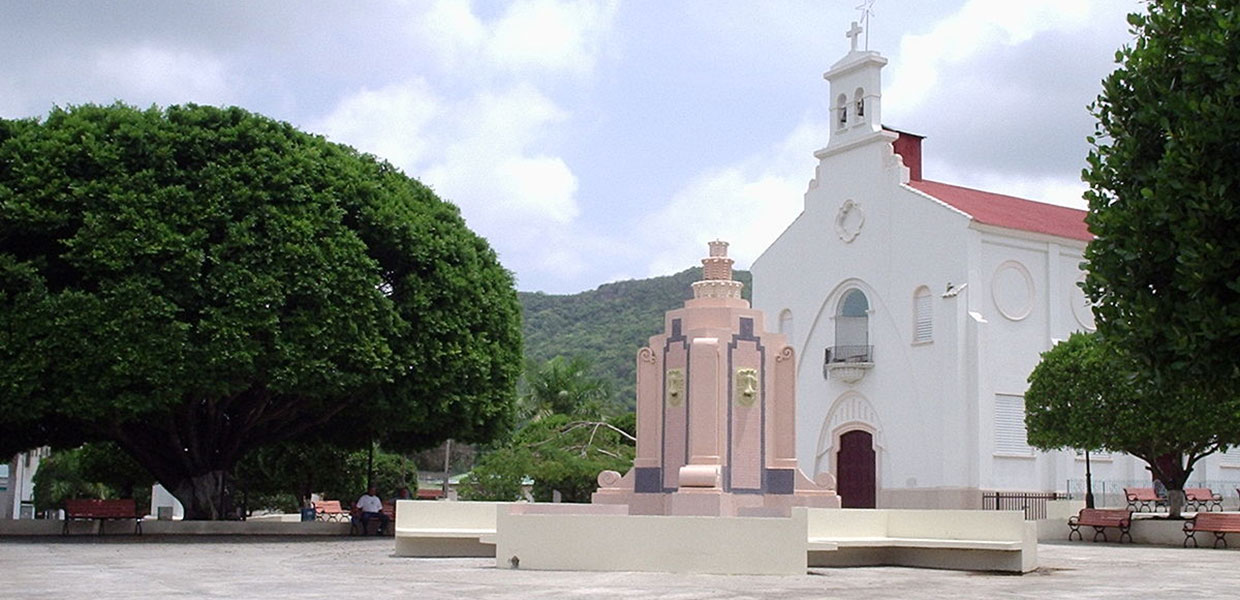
Peñuelas, Puerto Rico
Valley of the Flame Trees
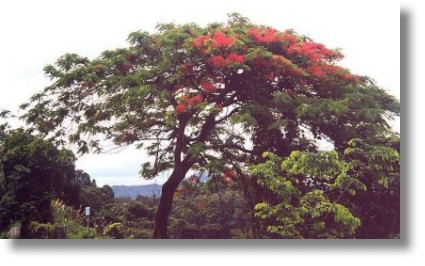
Peñuelas (PAIN-wai-lahs) is known as “The Valley of the Flamboyan Trees” and “The capital of the Güiro”. The patron saint is Holy Christ the Healer and the festivities held in his honor are held in September. There are also musical festivals during the summer months.
The town is located on the south coast of the Island and is bordered by Adjuntas to the north, the Caribbean Sea to the south, Ponce to the east, and Guayanilla to the west. It is located on the southern coastal plains, but the northern part of its territory is located in the central mountain range.
One of the seven sections of the Guilarte State Forest is located in the northern part of this town (Barreal and Jaguas wards). The Tallaboa Valley, which is comprised of the Tallaboa River and the surrounding alluvial plain, is also located in this municipality. Mapancha Cave is located in Coto ward in Peñuelas.
The economy is based mainly on coffee, produce, cattle, and fishing. Although during the 1950s this town was considered an important center for the petrochemical industry, the industrialization process has stagnated.
Foundation:
Peñuelas was founded by Diego de Alvarado. In 1745 a group of peasants settled in basin of the Guayanés river with intentions to cultivate de valley. This group increased gradually, and by 1788 there were about 80 families that cultivated the land and raised cattle.
Due to the great amount of contraband in the “Tallaboa Port”, pirates, and all sorts of crime, the inhabitants decided to move their settlement to the site where the actual town is located in search of security, protection and peace of mind. Its in this site where the settlers under the leadership of Diego de Alvarado constituted the nucleus of Peñuelas.
On August 25, 1793 after numerous negotiations by the citizens, the municipality of San José de Peñuelas was founded and the parish was erected. The name Peñuelas derives from the great boulders (peñascos) or “seborucos”, which in Taíno language means boulder or small rocks.
On March 1, 1902 the Legislature Assembly of Puerto Rico approved a law, the Consolidation of Certain Municipal Terms which annexed Peñuelas, all its civil servants and wards to Ponce. Three years later in 1905, the Assembly revoked the law, constituting again the municipality.
Location:
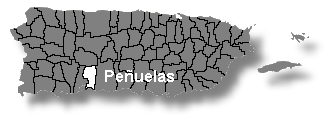 It is located in the southern part of the Island. It borders north with Adjuntas, south with the Caribbean Sea, east with Ponce and west with Guayanilla.
It is located in the southern part of the Island. It borders north with Adjuntas, south with the Caribbean Sea, east with Ponce and west with Guayanilla.
Area:
117.0 sq km / 45.0 sq mi
Population:
26,719 (census 2000)
Population Density:
228.3 per sq km / 593.7 per sq mi
People are known as:
Peñolanos
Peñuelas is also known as:
Valle de los Flamboyanes (Valley of the Flame Trees)
La Capital del *Güiro (Güiro Capital)
* Indian percussion instrument.
Wards: Peñuelas, Puerto Rico
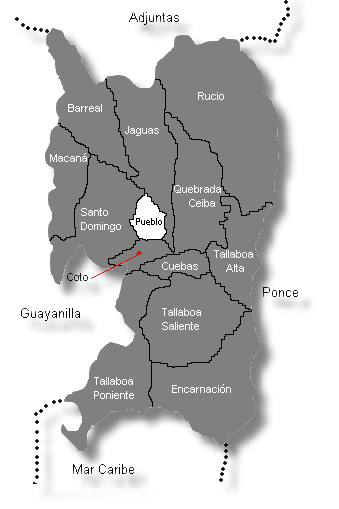
| Census 2000: Population by Wards – Peñuelas |
Habitants |
| Barreal | 267 |
| Coto | 1,244 |
| Cuebas | 430 |
| Encarnación | 1,344 |
| Jaguas | 2,662 |
| Macaná | 826 |
| Peñuelas Town | 1,609 |
| Quebrada Ceiba | 5,345 |
| Rucio | 1,124 |
| Santo Domingo | 6,792 |
| Tallaboa Alta | 4,037 |
| Tallaboa Poniente | 697 |
| Tallaboa Saliente | 342 |
| Total |
26,719 |
Source: Censo 2000
Patron:
San José
San José Parish
Box 25
Peñuelas, P.R. 00624
(787) 836-1038
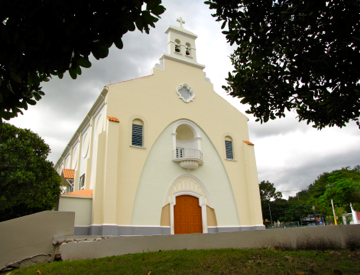
Topography:
Peñuelas belongs to the Southern Coastal Valleys, although the northern part is in the region of the Central Mountain Range.
Hydrography: It is bathed by the Macaná, Tallaboa y Guayanés rivers.
Economy:
Tourism, manufacturing and customer service.
Average Salary:
$281.55 weekly (1998)
Flag:
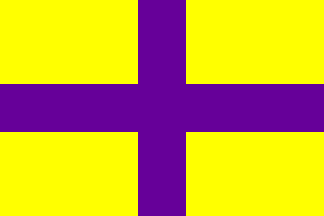 The flag was designed by a project of the Institute of Puerto Rican Culture. It has a rectangular bottom in yellow and stands for the sun, symbol of the physical life. In the center it has a purple or violet cross: symbol of Christianity and its ecclesiastical order; it represents the spiritual life. The cross purple extends to all the points of the yellow rectangle, like symbol of Christianity and the Church in our universe.
The flag was designed by a project of the Institute of Puerto Rican Culture. It has a rectangular bottom in yellow and stands for the sun, symbol of the physical life. In the center it has a purple or violet cross: symbol of Christianity and its ecclesiastical order; it represents the spiritual life. The cross purple extends to all the points of the yellow rectangle, like symbol of Christianity and the Church in our universe.
Coat Of Arms:
 It was created in the 1974, by a project of the Institute of Puerto Rican Culture, under Mr. Rodríguez and financed with federal funds. The adornment above the shield, a stone wall, represents the perpetuity. The cross represents Santo Cristo de la Salud that stopped the sea that flooded Peñuelas. The purple arm represents the priesthood and the town of Peñuelas. The yellow represents the sun. The blue and white symbolize the choppy sea and the regal ensign represents the faith in Christianity, “In God We Trust”.
It was created in the 1974, by a project of the Institute of Puerto Rican Culture, under Mr. Rodríguez and financed with federal funds. The adornment above the shield, a stone wall, represents the perpetuity. The cross represents Santo Cristo de la Salud that stopped the sea that flooded Peñuelas. The purple arm represents the priesthood and the town of Peñuelas. The yellow represents the sun. The blue and white symbolize the choppy sea and the regal ensign represents the faith in Christianity, “In God We Trust”.
Places To Visit:
- Guilarte State Forest
- Spanish Cannon – located on the Fire House
- Sopladera Pond
- The Chimney – remains of the former sugar economy
- Del Convento Caves
- Finca Guaraguao – eco-tourism area
- Hacienda Villa Flor – recreational Area
- Evangelical Church
- San José Catholic Church
- The Locomotive
- Monument to Pedro Albizu Campos
- Monument to Angel Pacheco Alvarado
- Monument to Holy Christ, the Healer
- Monument to the Unknown Soldier
Events:
- Endless Fun Festival – April
- Festival of the Cross – May
- National Güiro Festival – May
- Festival of the Flamboyan Tree – Summer
- Children’s Festival – August
- Patron Saint’s Festival – September
- Folk Festival – October
- The Cantatas – December
Distinguished Citizens:
- Lorenzo A. Balasquide – Writer and historian.
- Luis Díaz Hernández – Writer and historian.
- Egla Morales Blouin – Poet. Professor of Spanish, French, and Latin in Texas and New York.
- José Novoa González – Representative to the House of Representatives for the 23rd district (1973 – 1976).
- Guillermo Rivera – Bibliographer, essayist, and translator. Professor at Harvard and Cornell.
- Alfonso Santiago Cruz – Dean of the Department of Arts and Humanities of the Catholic University of Ponce.
Public Schools sorted by educational levels.
Peñuelas District
| Name | Level | Telephone | Address |
| ADOLFO GRANA RIVERA | Elementary | (787) 836-1005 | PO Box 097 |
| ELEMENTAL TALLABOA ALTA | Elementary | (787) 836-3766 | PO Box 70 |
| FELIPE QUIÑONES | Elementary | (787) 836-4741 | PO Box 927 |
| LA GELPA | Elementary | (787) 836-0314 | PO Box 70 |
| MIGUEL GONZÁLEZ BAUZA | Elementary | (787) 836-0972 | PO Box 839 |
| PEDRO MALDONADO TORRES | Elementary | (787) 836-0186 | PO Box 927 |
| TALLABOA ALTA 1 | Elementary | (787) 836-2100 | PO Box 70 |
| TALLABOA PONIENTE | Elementary | (787) 836-0203 | PO Box 70 |
| WEBSTER | Elementary | (787) 836-1216 | PO Box 549 |
| BARRIO SANTO DOMINGO | Intermediate | (787) 836-3577 | PO Box 899 |
| RAFAEL IRIZARRY RIVERA | Intermediate | (787) 836-1177 | PO Box 1264 |
| INTERMEDIA TALLABOA ALTA | Secondary | (787) 836-2100 | PO Box 70 |
| RAMÓN PÉREZ PURCELL | Secondary | (787) 836-3577 | PO Box 899 |
| JORGE LUCAS VALDIVIESO | Secondary | (787) 836-1105 | PO Box 659 |
| SUPERIOR URBANA (NUEVA) | High School | (787) 836-1665 | PO Box 1278 |
Hymn:
Así Es Mi Pueblo By José Tony Santos
Patillenses, El valle de Guyaboa te ha legado,
firmeza de sus peñas, del indio su valor,
del mar enfurecido tu Cristo te ha salvado,
tus hijos han frustrado, con sangre, al agresor.
Tus Aguas, las lágrimas de indígenas mejillas,
son fuentes de engría, frescura y flacidez,
tejiendo tus montañas, feraces maravillas,
susurran sus dolencias al Río Guayanés.
Viva Peñuelas, deportes, tradiciones,
viva su güiro, instrumento vegetal,
artesanos, poetas, trovadores,
que viva su talento musical.
De tu grandeza, humilde peñolano,
desde el cerrote al mundo le diré,
que así es mi pueblo, que a todos da la mano,
hospitalario, de paz, amor y fe.

